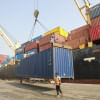Local berth operators want to invest in Ctg port’s oldest terminal

Local berth operators want to invest in and operate the oldest terminal at Chattogram port, the General Cargo Berth (GCB), under a long-term public-private partnership (PPP) arrangement.
The Bangladesh Ship Handling and Berth Operators Association and the Terminal Operators Owners Association submitted the proposal to the Chattogram Port Authority (CPA) on Monday.
The associations proposed forming a consortium of local and foreign investors to redevelop and operate the terminal for 25 to 30 years.
Fazle Ekram Chowdhury, president of the Bangladesh Ship Handling and Berth Operators Association, handed over the plan to CPA Chairman Rear Admiral SM Moniruzzaman at the port office, in the presence of operators currently managing the GCB jetties.
According to a preliminary feasibility study conducted by consultancy firm BDRS Ltd, the GCB remains the port's oldest and most vulnerable terminal.
Six of its jetties were constructed in 1954, while the others were rebuilt in 1979. All 12 jetties have exceeded their economic lifespan and require phased reconstruction, along with new equipment for efficient handling.
The study estimated that an investment of around $627 million (Tk 7,650 crore) would be needed to modernise the GCB.
Currently, the 12 jetties are run by 12 private operators under tender-based contracts introduced in 2010, following a trial period that began in 2007. Six jetties handle container operations, while the rest deal with general cargo unloading and handling.
"The berth operators already have long experience in managing GCB jetties," Ekram said while speaking to reporters.
"Based on this expertise, we want to modernise and operate the terminal through a PPP initiative. With both domestic and foreign investment, we will be able to enhance the port's handling capacity and provide services that match global standards."
He also emphasised that the initiative would safeguard existing jobs, create new employment opportunities, and ensure that the economic benefits of the investment remain within the country, contributing to national growth.

 For all latest news, follow The Daily Star's Google News channel.
For all latest news, follow The Daily Star's Google News channel. 




Comments